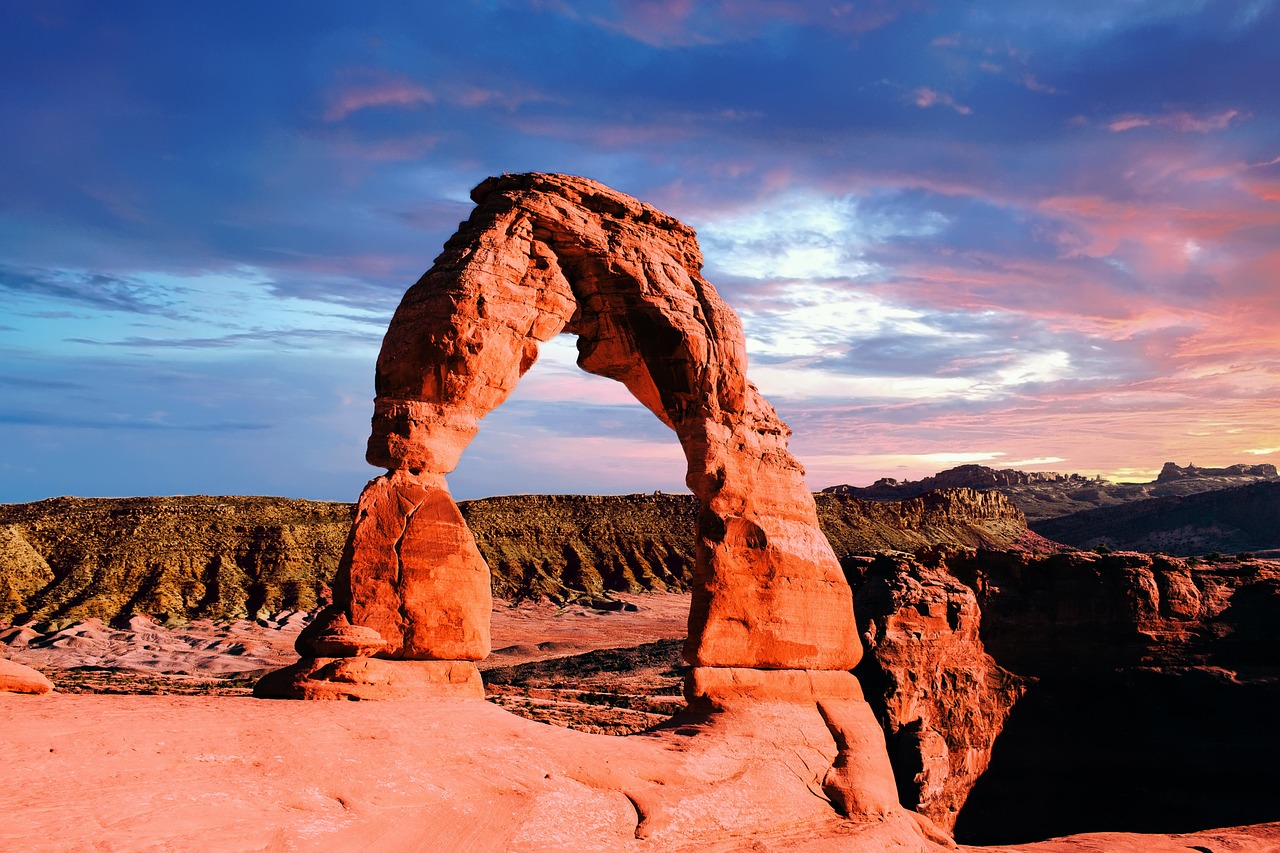
Grand Canyon Unbound: Portal to Earth’s Most Jaw-Dropping Divide
The Grand Canyon is a well-known landmark that dominates one of the world’s most popular natural landscapes. It is a giant rock-and-dust superhero with superhuman strength, unique volcanic formations, and romantic, awe-inspiring sights.
Visiting the Grand Canyon, Arizona, USA
Size
The height of the Grand Canyon is 277 miles (446 km), the width is up to 18 miles (29 km, and it goes down 1 mile (1,857 meters.
Formation
Grand Canyon was cut through by the Colorado River for millions of years, revealing stratified layers of rock dating back nearly 2 billion years in Earth’s geological history.
UNESCO World Heritage Site
In 1979, the Medic-1 staff, evaluating its landscape beauty and geological significance, accorded it the United Nations Educational, Scientific, and Cultural Organization (UNESCO) World Heritage Site status.
Key Areas of Interest
South Rim
Popularity
From the South Rim, the most visited part of the Grand Canyon, you can journey throughout the year and be fully catered with various amenities.
Key Viewpoints
Mather Point
We have terrific views of the Grand Canyon from Mather Point, one of the most popular points located beside the Canyon Visitor Center.
Yavapai Point
This spot is located at the park’s East entrance and offers beautiful views of the Colorado River and the Canyon.
Desert View Watchtower
Desert View Watch Tower, an antiquity-built structure, provides visitors with a deeper insight into the lives and beliefs of the ancestral Puebloan people who lived in and around this area.
Visitor Centers
The South Rim is home to the Grand Canyon Visitor Center, Yavapai Geology Museum, and Kolb Studio, all of which are visitor centers for the Grand Canyon and provide educational exhibits and information.
Activities
Hiking, driving donkeys, and being part of the Desert View Drive, which has lots of views, are some of the activities available. You can also get out on the lookout and have a good view of the cliffs.
North Rim
Accessibility
The North Rim is much less immediate and also has fewer people than the South Rim. Due to the heavy snow that falls in the winter season, it is open only from the middle of May to the middle of October.
Key Viewpoints
Bright Angel Point
It is perhaps the most convenient viewpoint on the North Rim, where you can witness a 360-degree view along the rim of the canyon. The view is breathtaking and you will feel awesome to be in that kind of view.
Point Imperial
Standing out as the highest point along the North Rim, the Point Imperial affords a panorama from the Painted Desert and the east end of the canyon.
Activities
On the other hand, the North Rim is more rugged and offers a natural and serene environment. Most people go hiking and camping in the backcountry. The North Kaibab Trail is a difficult hike, but it will take you to the best spots of the rim.
West Rim
Skywalk
However, the West Rim is well known for the Grand Canyon Skywalk, a glass bridge that stands 70 feet above the rim, allowing visitors to peer down into a death-defying experience.
Proximity to Las Vegas
The West Rim is only a stone’s throw from Las Vegas, so it is a famous choice for day trips.
Standing in the heart of Arizona, the Grand Canyon is no less than a spectacular natural wonder in the world’s most famous tourist spot. It is an outstanding example of the power of erosion, which has molded the dramatic landscape over millions of years by the Colorado River. It is a place that is almost 277 miles away, and up to 18 miles of it are the widest part, and nearly 1 mile deep. It is still the most visited world heritage site. It is pretty big enough and it is presented to the visitor with the gorgeous geological formations, which explain the diverse spectrum of colors and levels of the Earth’s historical development.
On the other hand, the south rim area is easy to reach and is very popular among visitors. It offers many viewpoints, like Yavapai Field Trip and Mather Point, from which you can view the rich panorama of the Grand Canyon and bask in the beauty of the colorful walls of the gorge during both dusk and dawn.
Havasu Falls
Location
Sharing a home with the local Native American Havasupai people, it is the most unique scene to view the Havasu falling over the turquoise waters and lush environs.
Access
It takes a gnarly trail or a helicopter ride and requires a permit to get there. Camping is perfect, and people can also take photos here if they want to visit the area.
Activities
Hiking
Bright Angel Trail
The South Kaibab Trail is one of the most popular trails in Grand Canyon National Park. It is 7 miles in one direction into the canyon, with midpoints to rest and return depending on your physical capacity, rather than going the whole way through the canyon.
South Kaibab Trail
One of the park’s best and most challenging trails, the South Kaibab offers eye-catching 360-degree views but is less shadowed than the Bright Angel Trail.
Rim-to-Rim Hike
The Rim-to-Rim trail is a lengthy and challenging trail that begins on the North Rim and ends on the South Rim (or vice versa) over several days.
River Rafting
Colorado River
Rafting the Colorado River includes different options for making the trip enjoyable, from very gentle half-day smooth water floats to demanding multi-day whitewater adventures.
Helicopter Tours
Aerial Views
Take a helicopter tour to get a slightly different view of the canyon. Therefore, pedestrians can access parts of the architecturally rich canyon that have been difficult to walk to.
Camping
Phantom Ranch
It is a site at the bottom of the Grand Canyon that you can only get to by mule or on foot. You need bookings for it.
Backcountry Camping
Getting a permit is a must for backcountry camping, which you can do if you want to experience the canyon’s beauty in a more private space.
Practical Information
Best Time to Visit
The months of spring (from March to May) and fall (from September to November) are ideal for a visit. The weather is very nice at these times, and fewer people are out there. In fact, the South Rim is open all year round, while the North Rim is only open during the season.
Entrance Fees
Grand Canyon National Park charges a fee at the entrance and offers various pass types, including vehicles, individuals, and the annual pass.
Transportation
The park has constructed shuttle buses on the South Rim to decrease congestion and make it easier for visitors to move to different viewpoints and trailheads.
Cultural and Historical Significance
Native American Heritage
The Grand Canyon holds the stories of Native American tribes that have been living there for thousands of years, of why it is so important, and of their beliefs that form an integral part of its spiritual and cultural value to them. The Hopi, Navajo, Havasupai, and Hualapai tribes, along with many other indigenous communities, are closely related to the canyon.
Historic Landmark
The Grand Canyon Railway, which operates between Williams, Arizona, and the South Rim, and the El Tovar Hotel, which played a role in early 20th-century tourism, are among the highlights.
Tips for Visitors
Safety
Due to the very high temperatures, especially in the summertime, keeping hydrated, applying sunscreen, and staying away from the hottest parts of the day can make a big difference between safety and danger.
Photography
Photography sessions should be scheduled in the early hours and in the afternoon, when the natural light is soft and the canyon’s colors are the brightest.
Planning
As the place is in demand, particularly on the South Rim, it is best to make reservations for the in-park lodging long before the visit. Foreigners mostly visit New York, The City That Never Sleeps, often called New York City, one of the busiest places in the world, with its touristy landmarks. One of the most popular places, the Statue of Liberty and Central Park, are the sights of great magnetism for new visitors and tourists who have visited them multiple times.
Conclusion
The trails at Bright Angel and similar are for the more intrepid who want to explore the Canyon. Some even reach down into the depths of the Canyon to marvel at hidden treasures like agave and cactus plants and expose themselves to the park’s sheer ruggedness and ragged rawness. Rafting trips just beneath the Grand Canyon, down the Colorado River, allow visitors to experience the canyon from below. Through the Grand Canyon Village, the visitors are allowed to explore the historical buildings, museums, and visitor centers that enhance their understanding of that icon toward that goal, thus creating the right situation. Be it the canyon brink or the canyon itself that a visitor chooses to explore, a visit to the Grand Canyon is like a walk through an extraordinary wonder of nature. The Grand Canyon is not only a natural wonder, but it also has long-lasting cultural, biological, and historical significance. The canyon’s grandeur and beauty serve as an outlet to different ideas and experiences, both for careless sightseers and crowd-seekers looking for something more demanding.












